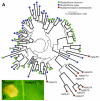Signatures of adaptation to obligate biotrophy in the Hyaloperonospora arabidopsidis genome
- PMID: 21148394
- PMCID: PMC3971456
- DOI: 10.1126/science.1195203
Signatures of adaptation to obligate biotrophy in the Hyaloperonospora arabidopsidis genome
Abstract
Many oomycete and fungal plant pathogens are obligate biotrophs, which extract nutrients only from living plant tissue and cannot grow apart from their hosts. Although these pathogens cause substantial crop losses, little is known about the molecular basis or evolution of obligate biotrophy. Here, we report the genome sequence of the oomycete Hyaloperonospora arabidopsidis (Hpa), an obligate biotroph and natural pathogen of Arabidopsis thaliana. In comparison with genomes of related, hemibiotrophic Phytophthora species, the Hpa genome exhibits dramatic reductions in genes encoding (i) RXLR effectors and other secreted pathogenicity proteins, (ii) enzymes for assimilation of inorganic nitrogen and sulfur, and (iii) proteins associated with zoospore formation and motility. These attributes comprise a genomic signature of evolution toward obligate biotrophy.
Figures


Comment in
-
Plant science. Genome evolution in plant pathogens.Science. 2010 Dec 10;330(6010):1486-7. doi: 10.1126/science.1200245. Science. 2010. PMID: 21148378 Free PMC article.
References
-
- Holub EB. European Journal of Plant Pathology. 2008;122:91.
-
- Coates ME, Beynon JL. Annu Rev Phytopathol. 2010;48:329. - PubMed
-
- Clark J, Spencer-Phillips P. Encyclopedia of Microbiology. vol. 2. Academic Press, Inc.; 2000. pp. 117–129.
-
- Giresse X, Ahmed S, Richard-Cervera S, Delmotte F. J. Phytopathol. 2009;158:321.
-
- Goker M, Voglmayr H, Riethmuller A, Oberwinkler F. Fungal Genet Biol. 2007;44:105. - PubMed
Publication types
MeSH terms
Substances
Grants and funding
- BB/E024815/1/BB_/Biotechnology and Biological Sciences Research Council/United Kingdom
- BB/C509123/1/BB_/Biotechnology and Biological Sciences Research Council/United Kingdom
- 079643/WT_/Wellcome Trust/United Kingdom
- BB/F0161901/BB_/Biotechnology and Biological Sciences Research Council/United Kingdom
- T12144/BB_/Biotechnology and Biological Sciences Research Council/United Kingdom
- EP/F500025/1/BB_/Biotechnology and Biological Sciences Research Council/United Kingdom
- BB/E007120/1/BB_/Biotechnology and Biological Sciences Research Council/United Kingdom
- BB/G015244/1/BB_/Biotechnology and Biological Sciences Research Council/United Kingdom
- BB/E024882/1/BB_/Biotechnology and Biological Sciences Research Council/United Kingdom
LinkOut - more resources
Full Text Sources
Molecular Biology Databases

